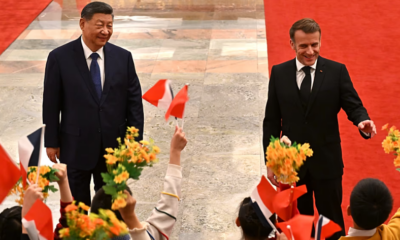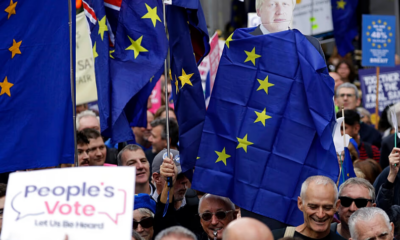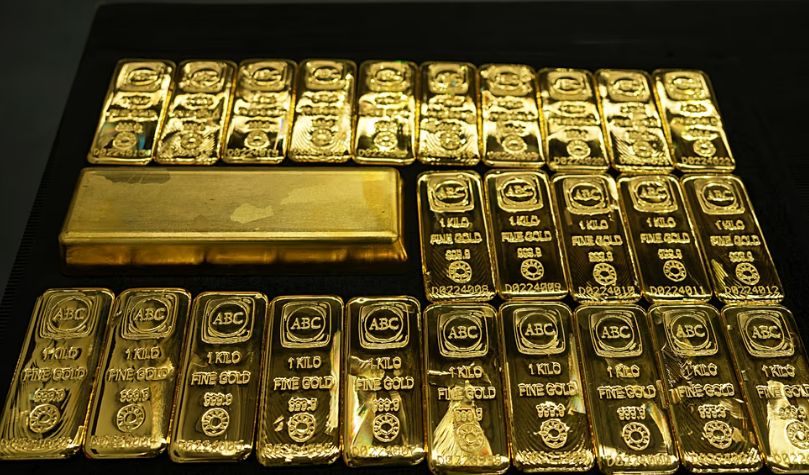Business
Global Luxury Sector Faces New Blow as US-China Trade War Escalates
The global luxury industry, already grappling with declining demand and changing consumer habits, faces a new hurdle as the trade war between the United States and China intensifies. Analysts warn that the sector’s fragile recovery may be further threatened by President Donald Trump’s recent decision to hike tariffs on Chinese goods to as high as 245%.
According to a memorandum seen by Euronews, the luxury market is forecasted to grow modestly at 1% to 3% annually between 2024 and 2027. This is a sharp slowdown compared to the 5% yearly growth seen between 2019 and 2023, and 9% between 2021 and 2023, as highlighted in a report by McKinsey.
China and the US are two of the largest luxury markets globally. In 2023, China accounted for 22%–24% of global luxury consumption, while US consumers contributed around 21% of total revenue in 2024, according to Bain & Company and Bank of America. Popular products in both markets include handbags, cosmetics, footwear, and leather goods, with brands such as Chanel, Dior, Louis Vuitton, Gucci, and Prada dominating sales.
However, economic slowdowns in both countries, combined with rising inflation and interest rates, have already caused luxury shoppers to scale back. The cost of living crisis in several regions has shifted consumer preferences toward more durable and budget-conscious purchases. Furthermore, luxury brands that raised prices post-pandemic without matching innovation are losing their exclusivity appeal.
The latest round of US tariffs, coupled with retaliatory Chinese tariffs currently at 125%, have added fresh uncertainty to the sector. Global stock markets have responded negatively, wiping billions in market capitalization from luxury giants. Shares of Lululemon Athletica dropped 20.7% on Nasdaq, Prada Group fell 23.4% on the Hong Kong Stock Exchange, and Kering and LVMH declined 26.3% and 19.9% respectively on Euronext Paris.
LVMH, often seen as a bellwether for the luxury industry, reported a 2% dip in Q1 2025 revenue to €20.3 billion. Fashion and leather goods revenue dropped 4%, perfumes and cosmetics remained flat, and wines and spirits fell 8%. Only watches and jewelry showed growth with a modest 1% increase.
Beyond China, US tariffs on EU goods—although reduced to 10% temporarily—also pose risks. The US imports various luxury products from Europe, including wine, chocolate, high-end apparel, and cars. These tariffs could increase prices for American consumers, potentially leading to reduced spending.
Additionally, the fragmented and globalized supply chains of luxury brands may incur hidden costs due to tariffs, further squeezing margins and complicating logistics.
In a surprising twist, the rising cost of luxury imports has led some Chinese manufacturers to promote knock-off products directly to US consumers via platforms like TikTok. Claiming to be original equipment manufacturers, they offer imitations of products like Birkin bags and Lululemon leggings at steep discounts. While their claims are largely unverified, Chinese wholesale platform DHgate has surged to the number two spot on the US Apple App Store, signaling growing consumer interest in alternatives amid rising prices.
As trade tensions deepen, the luxury sector is bracing for further disruptions in an already turbulent market landscape.
Business
Silver Surges Past $60 as Supply Strains, Rate Expectations and Tariff Concerns Drive Rally

Silver prices have surged to levels not seen before, rising above $60 an ounce this week after months of rapid gains driven by tightening supply, shifting Federal Reserve expectations and uncertainty around potential US trade actions. The metal hovered near $62 on Wednesday, extending a rally that began early this year when prices averaged around $30.
The latest jump came ahead of the Federal Reserve’s meeting, where investors expect another cut to the benchmark interest rate. The timing of the central bank’s leadership transition has added another layer of speculation. The US administration is reviewing finalists to replace Jerome Powell as chair, with Kevin Hassett, a senior economic adviser during Donald Trump’s presidency, reported to be the leading contender.
Market analysts say the candidates under consideration favour sharper rate reductions than those overseen by Powell. Since September, the Fed has trimmed rates twice by a quarter point each time. The gentler pace of easing has already pressured returns on cash and fixed-income assets, prompting many investors to shift into precious metals, which typically attract interest when rates fall. Silver, which does not generate yield, becomes more appealing in such an environment. Its performance has even outpaced gold, which has risen about 60 percent this year to reach record highs.
At the same time, traders are monitoring signals from Washington about whether silver could be targeted with tariffs. The metal was added in early November to the US government’s 2025 Critical Minerals List, a classification usually applied to resources seen as essential for national economic security. The designation places silver within the range of potential Section 232 investigations, the mechanism used in past years to justify tariffs on imported steel and aluminium.
Section 232 allows restrictions on imports deemed to put the country at risk through heavy dependence on overseas supply. No investigation has been launched, and officials have not indicated that tariffs are imminent. Still, the possibility has unsettled markets. Any duties on imported silver could reshape trade patterns and raise costs for domestic manufacturers, leading some buyers to boost inventories as a precaution.
Industrial use is also adding upward pressure. Demand from electric vehicle and solar panel manufacturers continues to rise, with these sectors relying on silver for components essential to production. Industrial consumption represents more than half of global silver use, and the combination of tight supply and strong manufacturing needs has intensified the rally.
Analysts say the market remains highly sensitive to signals from the Fed and the White House, with both interest-rate policy and trade decisions poised to shape the direction of prices in the months ahead.
Business
US Allows Nvidia to Sell H200 Chips to Approved Chinese Customers With 25% Surcharge
Business
Gold Looks to 2026 After a Record-Breaking Year Marked by Geopolitical Tension and Strong Central Bank Demand
-

 Entertainment1 year ago
Entertainment1 year agoMeta Acquires Tilda Swinton VR Doc ‘Impulse: Playing With Reality’
-

 Business2 years ago
Business2 years agoSaudi Arabia’s Model for Sustainable Aviation Practices
-

 Business2 years ago
Business2 years agoRecent Developments in Small Business Taxes
-

 Home Improvement1 year ago
Home Improvement1 year agoEffective Drain Cleaning: A Key to a Healthy Plumbing System
-

 Politics2 years ago
Politics2 years agoWho was Ebrahim Raisi and his status in Iranian Politics?
-

 Business1 year ago
Business1 year agoCarrectly: Revolutionizing Car Care in Chicago
-

 Sports1 year ago
Sports1 year agoKeely Hodgkinson Wins Britain’s First Athletics Gold at Paris Olympics in 800m
-

 Business1 year ago
Business1 year agoSaudi Arabia: Foreign Direct Investment Rises by 5.6% in Q1





























